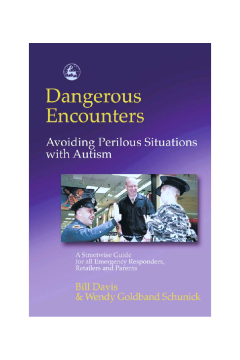
BOOK
Dangerous Encounters - Avoiding Perilous Situations with Autism
(2002)
Additional Information
Book Details
Abstract
Most emergency workers know very little about autism. This book explains what to look for and how to successfully handle encounters with people who have autism. It takes emergency responders and parents through everyday situations, stressing safety and awareness. This helps avoid the many problems that have and do arise when encountering autism in emergencies.
In addition, this book is aimed at retailers and retail security, as people with autism can look extremely suspicious in shops. For instance, a person with autism may well start to rearrange CDs or books by color. This can leave a wrong impression on a retailer who hasn't encountered autism before and lead to the police being called.
Both professionals and parents can work to prevent escalating situations. If given proper education, serious situations can be avoided when a person with autism is involved. This book contains practical appendices, such as emergency ID card instructions and how to make a travel communication safety book, as well as safety social stories that teach a person with autism how to act safely in emergency situations. It outlines a number of steps everyone can take and guidelines that can be followed. It is also a good training tool for emergency responders.
After reading this book you can really appreciate the extent to which personal safety relies on ones ability to communicate. I do believe the authors have succeeded in creating a guide which can be used for making the world a safer place for individuals with autism.
Security Journal Perpetuity Press
Dangerous Encounters states that most emergency workers know very little about autism and explains what to look for and how to handle successfully encounters with people who have autism. The authors take emergency responders and parents through typical day-to-day scenarios, focusing on safety and awareness, with guidelines that can be followed to help avoid the many problems that arise when encountering autism in emergencies. This approach makes the book a good training tool for emergency responders.
The Police Journal
Bill masterfully translates and suggests how to interpret common behaviors of people with autism for law enforcers, rescue personnel and other first responders. However, all people desiring a deeper understanding in making the world a safer and more understandable place for people with autism will benefit greatly from reading Dangerous Encounters. Bill's use of indoor shopping malls and other everyday surroundings for learning vital social skills are just some of the brilliant tools mentioned for parents and others working with people on the autism spectrum.
Stephen M. Shore, Board of Directors for Autism Society of America
Bill Davis has trained and spoken to many Police Departments, Fire Fighters, Ambulance workers, State Troopers, Group Home workers, Emergency Room workers, Universities, parents and Support Groups. Recently, he has received the Temple University's Center of Disabilities "End the Victim's Silence Advocacy Award". He has also been cited by the PA State Senate for work with the Police and the Disabled. He was a speaker at the PA Crime Commission Conference 2002 and at the Penn State Autism Conference 2002, and keynote speaker at Chapter Leaders ASA (Autism Society of America) in Dallas 2000. He is also past president of the Harrisburg Chapter ASA. Wendy Goldband Schunick has a Master's degree in social work and has been a television news producer in Washington DC and Baltimore. She was presented the World Hunger Media Award at the United Nations for a series about hunger in America, before deciding to start a family. She is currently a marketing writer. Bill Davis and Wendy Goldband Schunick are authors of Breaking Autism's Barriers, also published by Jessica Kingsley Publishers.
Bill's book touches on so many important aspects that parents and the general public need to know about when they have a child with autism in their homes or in their community. There are helpful hints for both parents and professionals on how to handle emergency and safety situations and how to prepare for such events before your family ever would face them. Do you know what to do if your house is on fire? Will your child with autism respond properly to the firefighters? Will they respond properly to your child? Don't wait until you are in the situation. Bill Davis lays out a clear outline for both you and the professionals that can help your family. Take his advice and take the time to help educate those people in your neighborhood so that your family will be safe.
Shelley Reynolds, Unlocking Autism
